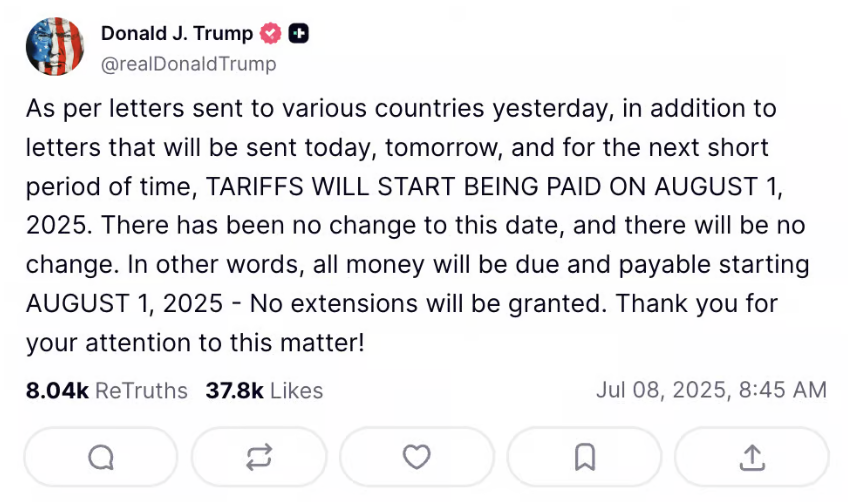Layoffs
What has President Trump said this week?
〰️
What has President Trump said this week? 〰️
1. Tariff Strategy Extended Again
President Donald Trump has again extended the deadline for his sweeping tariff plan, delaying implementation until August 1 after initially setting a July 9 trigger. The move buys additional time for countries to negotiate bilateral trade deals, but prolongs economic uncertainty and fuels market skepticism (CNN, 2025). Despite Trump’s firm rhetoric, declaring “no extensions will be granted”, investors and analysts remain unconvinced (CNN, 2025).
Todat, Wednesday, July 9, Trump revealed via Truth Social that new tariff letters had been sent to the leaders of the Philippines, Brunei, Moldova, Algeria, Iraq, and Libya, following earlier notices to 14 countries, including Japan, South Korea, and Indonesia. These letters imposed tariffs between 20% and 40%, with conditional language suggesting rates “perhaps” could be revised depending on diplomatic relations (CNBC, 2025).
Market response has so far been muted. After an initial selloff in April following Trump’s “Liberation Day” announcement, equities rebounded during the 90-day pause. But strategists warn that the lack of market panic could embolden Trump to follow through (CNN, 2025). Still, Trump appears aware of the perception. After investors shrugged off his most recent round of tariff threats, he took to Truth Social to assert: “TARIFFS WILL START BEING PAID ON AUGUST 1, 2025. No extensions will be granted”—a message aimed more at Wall Street than foreign leaders.
As of now, few major agreements have materialized. Only the UK and China have signed framework deals. Talks with the EU, Vietnam, and India remain stalled or strained. Without concrete progress, more than 20 countries may face steep new tariffs within weeks, unless, as investors expect, Trump blinks again.
2. Mass Federal Layoffs Greenlit
On Tuesday, the U.S. Supreme Court lifted a nationwide injunction that had blocked President Trump’s February executive order to initiate sweeping layoffs across federal agencies. The order instructs agency heads to coordinate with the Department of Government Efficiency on mass “reductions in force”, using mechanisms such as a 4:1 attrition rule, the non-renewal of temporary contracts, and expedited termination of underperformers. While the Court did not rule on the constitutionality of the layoffs, it allowed implementation during litigation, noting the administration is “likely to succeed” in defending the order’s legality (Wall Street Journal, 2025).
Labor unions and advocacy groups have condemned the move, warning it could displace “hundreds of thousands” of federal workers and dismantle essential services. During Trump’s first term, a similar proposal failed in Congress; this time, the administration acted unilaterally, prompting lawsuits against 21 agencies (NPR, 2025). U.S. District Judge Susan Illstonhad blocked the order in May, citing irreversible harm to federal operations, but her ruling was reversed this week.
The White House praised the decision as a “definitive victory”. Yet legal scholars caution that it may set a precedent for expanded executive control over the civil service, bypassing legislative oversight. Economists and agency leaders warn that sudden staff reductions could disrupt core government functions—particularly in regulatory, scientific, and social programs. With the August 1 implementation date nearing, uncertainty hangs over the future of federal employment and the structural balance between executive authority and institutional stability (Wall Street Journal, 2025; NPR, 2025).
3. Trump Signals Shift on Ukraine
President Trump has recently adopted a tougher stance on Russia, expressing frustration over President Putin’s handling of the war in Ukraine. In a July 8 Cabinet meeting, Trump said Putin was being “very nice” but “meaningless”in negotiations, and confirmed that the U.S. would send defensive weapons to Ukraine. He also said he is considering supporting new sanctions targeting countries that continue to import Russian oil or gas (NBC, 2025).
This marks a change from earlier this year, when U.S. envoy Steve Witkoff engaged in direct talks with Russian officials. Those talks have since stalled, and the Kremlin has said no progress was made during the leaders’ July 3 call. While the Kremlin maintains its long-term objectives in Ukraine, Trump has voiced disappointment that peace negotiations have not advanced (BBC, 2025, The Guardian, 2025).
At the NATO summit in June, European leaders emphasized defense cooperation, and Trump acknowledged the war would be harder to end than initially expected. Meanwhile, Russian media have described Trump’s approach as unpredictable, though the Kremlin said it remains open to further dialogue (BBC, 2025).
In private fundraisers last year, Trump claimed he warned Putin that a Ukraine invasion would trigger U.S. retaliation (CNN, 2025). Whether the current rhetoric leads to material shifts, such as expanded military aid or new sanctions, remains uncertain.


